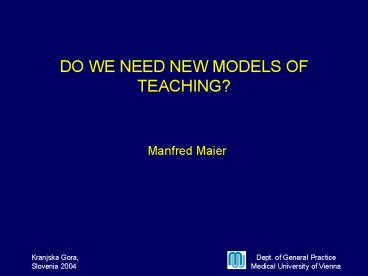Dept. of General Practice Medical University of Vienna - PowerPoint PPT Presentation
1 / 18
Title:
Dept. of General Practice Medical University of Vienna
Description:
late patient contact (Vienna 4.year) no reflection of the ... clinical skills ... teaching content based on epidemiological data from primary health care ... – PowerPoint PPT presentation
Number of Views:31
Avg rating:3.0/5.0
Title: Dept. of General Practice Medical University of Vienna
1
DO WE NEED NEW MODELS OF TEACHING?
- Manfred Maier
2
CHARACTERISTICS OF TRADITIONAL MEDICAL CURRICULA
- structured as sequence of disciplines
- teaching content defined by the disciplines
- cumulative growth of teaching content
- examinations in each discipline (currently 23)
- late patient contact (Vienna 4.year)
- no reflection of the current health care system
3
PROBLEMS WITH TRADITIONAL MEDICAL CURRICULA
- no relevance to practice situations
- overloaded with theory, cumulative factual
knowledge - knowledge cannot be implemented in daily work
- frequent and important problems not taught at all
- basic medical education unsatisfactory
- vocational training unsatisfactory
4
Medical education will not change medical
practice, medical practice will change medical
education
Georg Silver
5
(No Transcript)
6
THE BLOCK-LINE-MODEL
Theme 1
Theme 2
integrated themes knowledge
integrated assessment
- Morphology
- Function
- Diagnosis
- Therapy etc.
Morphology Function Diagnosis Therapy etc.
knowledge
knowledge
respective clinical examples POL line-element
clinical skills
7
(No Transcript)
8
PROFILE OF GRADUATES
- knowledge and understanding
- clinical skills
- communicative competences
- attitudes
- professional competences
9
PROFILE OF GRADUATES - EXCERPTS
- knowledge and understanding
- ...detailed knowledge and understanding of
frequent and urgent health problems or illnesses
and concepts for their treatment - clinical skills
- ability to recognize and correctly judge
emergency situations and to initiate first aid
measures - ability to propose a reasonable concept for
treatment of frequent illnesses under hospital-
and outpatient conditions
10
BASIS FOR THE TEACHING CONTENTLIST OF DIAGNOSES
- frequent and typical symptoms
- illnesses/diagnoses/problems in primary health
care and in hospitals (frequency gt 0,25) - supplemented by conditions according to
- - frequency
- - urgency
- - exemplaricity
11
ARGUMENTS FOR THE LIST OF DIAGNOSES
- based on epidemiological data
- guarantees relevant content
- fulfils didactic requirements
- helps to limit teaching content
- supports importance of relevant content for all
students (basic medical education) - selects content on a rational basis
- supports integrated teaching and learning
- does not support discipline oriented approach
12
INCLUSION OF COMMUNITY BASED AMBULATORY CARE
FACILITIES
- 1. section
- block 1(orientation)
- observation of various aspects of the occupation
- block 6 (environment, family and society)
- 2. section
- several blocks (specific themes, frequent
problems) - 3. section
- attachment to a GP practice once a week for one
semester - elective
13
GENERAL PRACTICE IN THE NEW CURRICULUM
- sections 1-3
- special study module (SSM, training in science
and research methodology) - clerkship 4 weeks obligatory (among 24 weeks
total) - diploma
- thesis
- final examination by faculty commission
14
GENERAL PRACTICE AND THE NEW CURRICULUM
- block line model
- horizontal and vertical integration
- teaching content based on epidemiological data
from primary health care - GP contributes to each of 3 sections of the
curriculum
15
STILL PROBLEMS?
- staff development (teaching, research)
- hidden curriculum driven by exams
- exams / assessment in GP? (BME PD CME)
- clinical electives, tutorials
- medical universities medical colleges
- do we attract the best students?
16
NEW MODELS?
- no, but we need
- to have a good structure for what and how we
teach - to aim at the best (learning, training,
retraining) - to be omnipresent in exams / assessments with
fair but difficult problems - to contribute to the goals of the university in
teaching and research
17
- Die Studenten sollen
- Denken und nicht
- Gedanken lernen.
- K. Jaspers
18
USEFUL LINKS
- www.lcme.org































